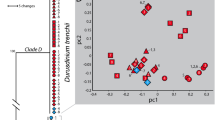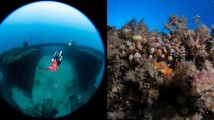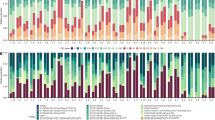Abstract
Many corals bleach as a result of increased seawater temperature, which causes them to lose their vital symbiotic algae (Symbiodinium spp.) — unless these symbioses are able to adapt to global warming, bleaching threatens coral reefs worldwide1,2,3. Here I show that some corals have adapted to higher temperatures, at least in part, by hosting specifically adapted Symbiodinium. If other coral species can host these or similar Symbiodinium taxa, they might adapt to warmer habitats relatively easily.
Similar content being viewed by others
Main
Around Guam, species of the coral genus Pocillopora each associate with at least two Symbiodinium taxa, one of which, according to ecological data4, seems to be more tolerant of high temperature. I tested whether this could be the case by comparing photosynthetic responses of the taxa, labelled according to their genotype, Symbiodinium C and Symbiodinium D (ref. 4) (for methods, see supplementary information). I measured the maximum quantum yield of photosystem II (PSII) as the ratio of variable chlorophyll fluorescence to maximum chlorophyll fluorescence (Fv/Fm)5 in P. verrucosa. In P. damicornis, I measured photosynthesis from oxygen flux.
Symbiodinium C and D respond in opposite ways to temperature, as indicated by their differing Fv/Fm (Fig. 1a). Compared with a control temperature of 28.5 °C, a temperature of 31.3 °C did not affect Symbiodinium C, but it increased Fv/Fm in Symbiodinium D; a temperature of 32.0 °C decreased Fv/Fm in Symbiodinium C, whereas Symbiodinium D maintained an increased Fv/Fm. Although Fv/Fm was similar in Symbiodinium C and D at 28.5 °C, at 32.0 °C Symbiodinium C could be identified by its lower Fv/Fm. After the temperature treatments, corals were kept at 28.5 °C; after three and four days, Fv/Fm in treated Symbiodinium C remained lower than in controls (P = 0.02) and unchanged from the value recorded at 32.0 °C (P>0.2), whereas Fv/Fm in control and treated Symbiodinium D had become similar (P>0.2; Wilcoxon paired-sample tests).
a, Afternoon values of maximum quantum yield of photosystem II (Fv/Fm) in Pocillopora verrucosa (mean and s.d.; n = 7); asterisks indicate differences (P<0.05) between corals at 28.5 °C and the same corals at 31.3 °C or 32.0 °C; inequalities indicate differences (P<0.05) between Symbiodinium C and D (both, Wilcoxon paired-sample tests). b, Afternoon values of Fv/Fm (mean±s.d., n = 7) in P. verrucosa hosting Symbiodinium D at 28.5 °C, plotted against daily average irradiance (PAR, photosynthetically available radiation; between 10:00 and 14:00); slope is not equal to zero (t-test, P<0.001); pre-dawn (three-day average) shows overnight recovery of Fv/Fm compared with preceding afternoons (asterisks: P = 0.02, Wilcoxon paired-sample test). c, Pmaxnet (positive) and R (negative, measured in the dark) of P. damicornis (mean and s.d.; n = 9). d, Pmaxnet:R from data summarized in c. In c, d, asterisks as in a; inequalities indicate differences between Symbiodinium C and D (P<0.05, Mann–Whitney U-test).
A long-lasting decrease in Fv/Fm, as observed in Symbiodinium C, indicates that chronic photoinhibition resulted from damage to PSII (refs 5–7). Repeated measures (Wilcoxon paired-sample tests) show that the decrease in Fv/Fm in Symbiodinium C at 32.0 °C compared with 31.3 °C (P = 0.02) was accompanied by a 20% increase (P = 0.02) in the minimum chlorophyll fluorescence in the dark-acclimated state (Fo) and no change (P>0.5) in Fm, confirming chronic photoinhibition5. Over the same time, both Fo and Fm decreased by 13% (P = 0.02) in control Symbiodinium C , suggesting an increase in photoprotection7. Fo and Fm did not change in Symbiodinium D under control or treatment conditions (P ⩾ 0.2).
Whereas chronic photoinhibition of Symbiodinium C indicates temperature sensitivity and predicts coral bleaching1,6,7, the increased Fv/Fm in treated Symbiodinium D indicates photoprotection. For Symbiodinium D, the relationship between Fv/Fm and irradiance exposure, which quantifies dynamic photoinhibition (reversible and protective) of PSII (refs 89; Fig. 1b), shows that increased temperature mimicked a 30% decrease in habitat irradiance at 28.5 °C. Photoprotection by increased temperature reflects the temperature dependence of photosynthetic pathways10. Thus, I conclude that Symbiodinium D is a high-temperature specialist. Plant models9 indicate that photoinhibition similar to that relieved by warmer temperatures in Symbiodinium D reduces daily carbon gain by 6–10%.
Oxygen-flux measurements independently support these conclusions and extend them to another host species at the whole-coral level. Increased temperature affected only corals hosting Symbiodinium C: maximum net photosynthesis (Pmaxnet) decreased; respiration (R) was not affected (Fig. 1c). At the higher temperature, the ratio of Pmaxnet to R (Pmaxnet:R) decreased by 31%, making corals hosting Symbiodinium C less autotrophic than corals hosting Symbiodinium D (Fig. 1d). Temperature did not affect numbers or the chlorophyll a of Symbiodinium C or D (P ⩾ 0.5, Wilcoxon paired-sample tests), so the decreased autotrophy did not result from lost symbionts.
Symbiodinium can differ physiologically owing to their acclimatization to different environments3, which probably include different host species. However, because I controlled for these variables, the differences observed here are regarded as intrinsic symbiont adaptations that apparently contribute significantly to whole-coral physiology. Adaptation to higher temperature in Symbiodinium D can explain why Pocillopora spp. hosting them resist warm-water bleaching whereas corals hosting Symbiodinium C do not (personal observations). It can also explain why Pocillopora spp. living in frequently warm (more than 31.5 °C) habitats host only Symbiodinium D (ref. 4), and, perhaps, why those living in cooler habitats predominantly host Symbiodinium C (ref. 4). These observations, which may apply to other corals11, indicate that symbiosis recombination12 may be one mechanism by which corals adapt, in part, to global warming3.
References
Hoegh-Guldberg, O. Mar. Freshwat. Res. 50, 839–866 (1999).
Hughes, T. P. et al. Science 301, 929–933 (2003).
Coles, S. L. & Brown, B. E. Adv. Mar. Biol. 46, 183–223 (2003).
Rowan, R. Ecology (submitted).
Maxwell, K. & Johnson, G. N. J. Exp. Bot. 51, 659–668 (2000).
Warner, M. E., Fitt, W. K. & Schmidt, G. W. Proc. Natl Acad. Sci. USA 96, 8007–8012 (1999).
Jones, R. J. & Hoegh-Guldberg, O. Plant Cell Envir. 24, 89–99 (2001).
Long, S. P., Humphries, S. & Falkowski, P. G. Annu. Rev. Plant Physiol. Plant Mol. Biol. 45, 633–662 (1994).
Werner, C. et al. Plant Cell Envir. 24, 27–40 (2001).
Huner, N. P. A., Oquist, G. & Sarham, F. Trends Plant Sci. 3, 224–230 (1998).
Baker, A. C. Annu. Rev. Ecol. Evol. Syst. 34, 661–689 (2003).
Rowan, R. & Powers, D. A. Science 251, 1348–1351 (1991).
Author information
Authors and Affiliations
Corresponding author
Ethics declarations
Competing interests
The author declares no competing financial interests.
Supplementary information
Supplementary Information
Experimental materials and methods are described under the following headings: Collection and maintenance of corals; Measurement of temperature and irradiance; Experimental conditions; Experimental designs; Measurements of variable chlorophyll fluorescence; and Measurements of net photosynthesis and respiration. (DOC 74 kb)
Rights and permissions
About this article
Cite this article
Rowan, R. Thermal adaptation in reef coral symbionts. Nature 430, 742 (2004). https://doi.org/10.1038/430742a
Published:
Issue Date:
DOI: https://doi.org/10.1038/430742a
This article is cited by
-
Lineage-specific symbionts mediate differential coral responses to thermal stress
Microbiome (2023)
-
Importance of depth and temperature variability as drivers of coral symbiont composition despite a mass bleaching event
Scientific Reports (2023)
-
Symbiotic dinoflagellates divert energy away from mutualism during coral bleaching recovery
Symbiosis (2023)
-
Branching coral growth and visual health during bleaching and recovery on the central Great Barrier Reef
Coral Reefs (2023)
-
Symbiont-mediated tradeoffs between growth and heat tolerance are modulated by light and temperature in the coral Montipora capitata
Coral Reefs (2023)
Comments
By submitting a comment you agree to abide by our Terms and Community Guidelines. If you find something abusive or that does not comply with our terms or guidelines please flag it as inappropriate.




